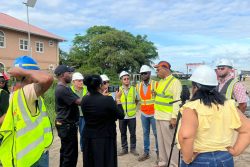Dear Editor,
The Ministry of Agriculture would like to correct inaccuracies in a letter published in your December 14 edition of Stabroek News where Dr Kenrick Hunte stated that Guyana’s agriculture sector is in a downward spiral in an attempt to discredit the work done by the government in resuscitating the sector.
It is unfortunate that when Dr Hunte had the opportunity to contribute to the development of Guyana’s agriculture sector his stint at the GAIBANK was short lived due to mismanagement of the bank’s financial resources resulting in its closure. However, he now makes loud pronouncements to discredit the efforts of the government without making any serious feasible suggestions or recommendations on what should be done instead.
The records will show the mismanagement and neglect by the previous administration towards the agriculture sector. In fact, when this government took office the performance of rice and sugar as well as the wider agriculture sector had reached their lowest point ever. In 1990 rice production was only 93,444 tons and exports had been reduced to 50,943 tons. Similarly, in the sugar industry only 129, 920 tons were produced in 1991.Farmers can recall the time when no infrastructure and inputs were available for their activities.
Obviously, if one is to follow closely the development/investment within the agriculture sector over the past few years it would reveal that Guyana’s agriculture is on a firmer, competitive footing which is evident due to the availability of fresh fruits and vegetables on the local market and the increase of exports to the Caribbean and further afield. Hence, Guyana has maintained its food secure status, despite the global food and financial crisis which is affecting many developed nations.
Further, the current government continues to make significant strides in the agriculture sector to support and develop farmers’ activities and Dr Hunte needs to go into the fields rather than sit at a desk and manipulate information to create mischief.
Guyana’s food security is no mirage; Dr Hunte needs to visit the market and the ports where tonnes and container-loads of agricultural produce continue to be exported on a daily basis produced by the very people Dr Hunte calls “aging farmers.” Farmers have evolved over the years as the Ministry of Agriculture continues to provide more user-friendly technology, improved breeding animals and improved planting materials. In addition to the ministry’s extension services, the ministry has also been conducting training programmes for farmers and potential investors at the Guyana School of Agriculture/National Agricultural Research Institute’s facility.
The Ministry of Agriculture, despite several challenges continued to execute its policies, programmes and projects geared towards modernizing and transforming agriculture and food production in Guyana. But sound macro-economic policy and continuous support for our farmers and other producers allowed us to develop a measure of resilience and overcome those hurdles.
As such we wish to highlight some of the notable achievements recorded over the past few years:
Commissioning of a massive $100M pesticide and toxic chemical control laboratory at Mon Repos.
Launching of the market-led ‘Grow More Food’ campaign which saw a marked increase in crops and livestock production and which not only assured our food security, but ensured that adequate supply was available for the export market as well.
The non-traditional crops sector recorded increased exports and introduced several new crops to overseas markets, traditional and new, throughout the Caribbean and North America. Our agro-investment seminars stirred large interest and this led to a number of new agro-business investments.
Commissioning of a state-of-the-art Doppler Weather Radar Project to ensure a reliable weather forecast to guide farmers in their activities.
State-of-the-art $89M agro-packaging facility was commissioned at Parika, East Bank Essequibo. This facility, together with the recommissioned Sophia Pack House, provides an invaluable service to farmers and exporters.
Recertification by the United States government to export shrimp and other fishery products to the United States. Improved breeds of cattle, sheep and swine acquired were multiplied and distributed, while additional small ruminant stocks for breeding and distribution were acquired through the ministry’s Livestock Improvement Programme. For the first time we successfully carried out embryo transfer to introduce a new sheep breed in Guyana.
To promote freshwater aquaculture a new hatchery was commissioned with a production capacity of over 200,000 female fingerlings per year.
Implementation of a US$6M Rural Enterprise and Agricultural Development Project and aUS$20.9M Agricultural Export Diversification Programme funded by the IDB and Government of Guyana. For the first time, we have been able to develop and attract funding for a national agriculture diversification strategy.
Approximately $1.58 billion (US$7.76 million) worth of fresh and processed agricultural produce was exported for 2008.
The promotion of shade house/greenhouse technology and seedling production. Shade houses and seedling houses have been constructed at Mon Repos, Fort Wellington, Anna Regina, Affiance, Christianburg, Kairuni, Bartica and Black Bush Polder.
More than 200 persons were trained in this technology. The cultivation of spices was initiated with the assistance of a spice expert from India. The four spices identified for commercialization are nutmeg, ginger, turmeric and black pepper. Trials are ongoing in hinterland regions. Planting materials were acquired locally and are currently being multiplied.
A $409M Dawa pump station re-commissioned in Region 2 to benefit 2,000 farmers. Construction and commissioning of two major sluices at Westbury and Golden Fleece, Essequibo Coast ($290M)
Guyana’s vast tracts of productive land present enormous opportunities for growth and investment in the agriculture sector. Agriculture already represents approximately 34 per cent of Guyana’s Gross Domestic Product and exports usually amount to over a third of Guyana’s total exports annually.
The foundation for continued growth in both food production and exports has been established. Our major agricultural diversification thrust and adaptation of our drainage and irrigation to climate change and other initiatives will be accelerated in the coming year to take agriculture to another level.
Is Dr Hunte serious about his statements or should it be seen as a means of attracting attention to himself to create a semblance of relevance by criticizing and misrepresenting government policies, programmes and achievements?
Yours faithfully,
George Jervis
Deputy Permanent Secretary
(Admin)





